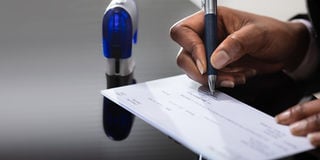Automating your personal finance system

The checking account is reinforced by a standing order. PHOTO| FOTOSEARCH
What you need to know:
- Don’t use one account for all your finances.
- Separate your accounts based on your obligations and undertakings.
A healthy personal finance status is made up of systems and processes that limit undesirable financial habits. These systems and processes work to streamline your finances, and to promote and secure your financial future. They are built around one pillar known as financial automation. Automation means that your money will be going where it needs to go. So, how do you set up and sustain an automated personal finance system? Let us take a look at some actions that you can take.
The first step you must take when automating your finances is bank accounts. You should open the right accounts to facilitate your automation. These include:
Checking account
This account is generally used for making payments including of bills and utility purchases. It is the equivalent of a current account. It will earn little to zero interest. However, it will allow for easy withdrawals and deposits. Some banks will charge you varying fees for maintaining the account while others may set minimum opening and operating balances. Shop for the most appropriate and affordable option. “The main purpose of opening this account is not to save, but to have a financial nerve centre from which money will come in and go out on a predetermined schedule,” says personal finance coach Edward Okumu. A checking account should be backed up by a proper layout of when your bills and financial obligations and targets fall due.
The standing order
The checking account is reinforced by a standing order. The standing order states the amount and the time when money should be automatically withdrawn from your current account to a savings or investment account. “I save my money through standing orders. I use the 80/20 rule where I put aside 80 per cent and consume 20 per cent. I have automated this saving process through standing orders to cooperatives, insurances and other shares,” says Timothy Njuguna, the operations manager at Moran Publishers (EA) Ltd, a school and general publishing firm in Nairobi. This is the same form of automation used by Maggie Ireri, a researcher and managing director of Trends and Insights for Africa Research Ltd. “I have a monthly standing order from my current account to a savings account. I accumulate money in the savings account for one year, and then I decide where to invest it,” she says. To set up a standing order, you need to go to your bank and sign an authorisation. This authorisation will include frequency and duration. For example, depending on when you expect money to come into your account, you can have a standing order that authorises your bank to make a specific withdrawal and deposit from your current to savings account every 10th of the month for a year.
The savings account
With the advent of technology, traditional and investment banks have savings accounts that automate the gradual growth of savings. Okumu says you can automate orders to your savings accounts so that they increase gradually on a monthly, quarterly or annual basis. “For instance, if you are pursuing the 52 Week Savings Challenge, you will need to increase your savings bit by bit weekly to end up with a specific target figure by week 52. Automation will facilitate this increase without creating loopholes for defaults,” he says.
Separate accounts
This is paramount. Don’t use one account for all your finances. Separate your accounts based on your obligations and undertakings. “Have separate accounts. An account where your business transactions are done, an account reserved for your spending budget, and an account that is strictly for saving and investing,” says Okumu.
Pay yourself first
Always pay yourself first the moment money gets to your checking account. One of the most efficient ways to do this is to automate a figure towards your emergency fund or retirement plan the moment your paycheck comes through. This principle should apply regardless of the other financial obligations you may be having such as loans. “The objective behind this concept is to have some money that can be used to expand your financial horizon in the long term,” says Okumu, adding that on average, 10 per cent of the income you earn should be your pay.
Check-ups
Once you have automated your finances, you will need to set up a corresponding calendar that alerts you to check your statements and payments to ensure that money coming in and going out of your account is deposited in the places you have instructed. These check-ups could come in handy where you need to make adjustments, for instance, in the event of salary delays to the checking account. While you don’t want to have lots of money lying idle in your checking account, you should avoid attracting additional overdraft fees. Check-ups will help you know the status of what is coming in, when, and what financial adjustments, if any, are needed.




